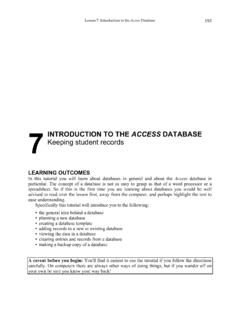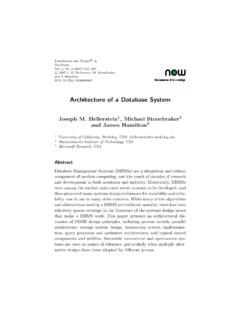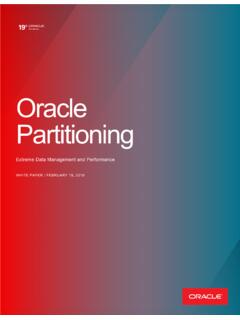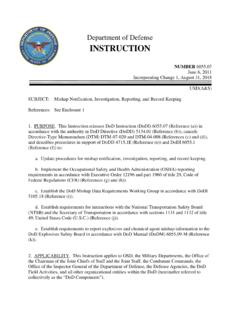Transcription of HSPICE - Stanford University
1 EE133. Winter 1999. Stanford University . Electrical Engineering Department HSPICE . 1. HSPICE introduction Page 2. 2. Running HSPICE Page 3. 3. Unix Basics Page 4. 4. Workstation Basics Page 8. 5. HSPICE Basics Page 12. 6. MetaWaves Basics Page 18. 7. Sample HSPICE Input Files Page 20. -1- 1. HSPICE introduction HSPICE is an analog circuit simulator (similar to Berkeley's SPICE-3) capable of performing transient, steady state, and frequency domain analyses. Existing SPICE decks created for SPICE- 3 can be easily modified to run under HSPICE , or can be rewritten to take advantage of features not available in SPICE-3. HSPICE generally has better convergence than SPICE-3 and, because it is a commercial product (from Meta-Software), is better supported. It also allows hierarchical node naming, circuit optimization, input, output, and behavioral algebraics for parameterized cells, and interactive waveform viewing with MetaWaves.
2 This handout contains basic information about HSPICE and MetaWaves, which should be suf- ficient for performing simple simulations. For more detailed information, consult the HSPICE US- ERS MANUAL (available from MetaSoftware directly at 800-346-5953 (note - ONLY use this number to order manuals: all technical questions should be directed to your TA)), or you can view an on-line version of the manual in the /usr/class/ee/ HSPICE /docs/Postscript directory. To view a section of the manual, you can use one of the postscript viewers (such as ghostview, or ghostscript). For example, to view the section from one of the elaine workstations, enter ghostview /usr/class/ee/ HSPICE /docs/ Don't try to print out sections of the manual using the cluster printers - the large files can cause the printers to hang, and you are allotted only 100 pages of printouts per quarter.
3 HSPICE has been installed on the Sweet Hall and Terman clusters, and runs on most DEC, HP, SGI, and SUN workstations. For a list of available computers, type help systems from any Sweet Hall or Terman computer, or ask the consultants on the second floor of Sweet Hall if you want a more up-to-date list. The following computers are currently available for running HSPICE and MetaWaves on the Sweet Hall cluster: amy1-amy29 (DEC3000/300LX), elaine1- elaine44 (Sun SPARC station 20), raptor1-raptor14 (SGI Indigo XZ), firebird1-firebird18 (SGI Indigo2 ex- treme), epic1- epic18 (SUN UltraSPARC), and adelbert1 - adelbert10 (SUN UltraSPARC). The raptor and firebird clusters are in the basement, and are intended primarily for CS students, but can be used during non-peak hours by all students (you can get the combination to the door lock from the consultants on the second floor).
4 In the Terman cluster (Terman 104) use theapollo1-apollo13. (HP9000/712) and voyager1-voyager8 (SUN SPARC station IPX) workstations. In addition, sim- ulations can be run remotely using X-Windows. All of these workstations share a common file server and account database. For specific instructions on a particular workstation, read the section entitled Workstation Basics later in this handout. More information on campus computer clusters is available in the handouts introduction to the leland systems, Unix Command Summary, and Using The X-Window System which are available on-line in the directory ~consult/pub/lair-docs or in the document rack in the northeast corner of the second floor of Sweet Hall. You can also get help from the consulting desk in Terman 104 or on the second floor of Sweet Hall. -2- 2. Running HSPICE .
5 The general procedure for analyzing a circuit is to use an editor ( vi, emacs, etc.) to create an input file, run HSPICE to generate graph and hardcopy data files, and run MetaWaves to view, customize, and print the resulting graphs. It is usually easier to start with an example input file (such as those at the end of this handout) and modify it to match the desired circuit. The commands found in the example input files and summary in this handout are sufficient to perform simple sim- ulations. For more sophisticated analyses consult the HSPICE USERS MANUAL. To run HSPICE , you must first open an X-window. The procedure for opening an X-window varies depending on the type of computer you are using. If you have questions, read the section on Workstation Basics later in this handout. Before running HSPICE , users should execute the command source /usr/class/ This will set your path correctly and initialize some environment variables (put this line in your.)
6 Cshrc file to avoid having to retype it each time you run HSPICE ). You may also want to customize some of the HSPICE control options assigned in the config- uration file At run time, HSPICE looks for a configuration file, searching first in the user's home directory, and then in the HSPICE installation directory (which contains a default ver- sion). If you wish to customize your configuration, copy the default file to your home directory using the command cp /usr/class/ee/ HSPICE /96 ~ You can then use an editor to make the desired modifications (such as setting the prtdefault vari- able to sweet1 (sweet1 can print on both sides of the page, so you won't go through your quota as fast)). Once you have opened an X-window, the procedure for running HSPICE is essentially the same on the various workstations. However, there are different versions of HSPICE installed on the different workstations, so you may notice slight differences.
7 To run HSPICE , enter the command HSPICE > You can also run HSPICE interactively by entering the HSPICE command by itself, and answering the questions. For more details on HSPICE , read the section HSPICE Basics, later in this handout. You can then view the simulation results by running MetaWaves on the output file created by HSPICE ( , , etc.): mwaves MetaWaves is an interactive menu-driven waveform viewer, which is described in more detail in the section MetaWaves Basics, later in this handout. -3- 3. Unix Basics Setting up your account If you don't have an account yet at Sweet Hall, see the document entitled introduction To The Leland Systems in the document racks on the second floor of Sweet Hall. It usually takes about 24. hours to get an account. Once you have an account you can access your home directory at any of the campus clusters.
8 Offsite SITN students HCP and NDO students wishing to open an on-campus account should, upon receiving confir- mation of registration containing your student ID number from SITN, go to the web page: Complete instructions for opening an account are described on the web page, with specific proce- dures for SITN students. You may have to wait up to one day for your account to appear. If you have questions or problems with the login procedure, contact the Sweet Hall consultants at the consulting desk on the second floor of Sweet Hall, or by calling 725-2101. If your account is frozen, or you have trouble with your ID, call SITN at 415-725-3016. X-Windows Basics The Sweet Hall workstations use an X-Windows environment. HSPICE behaves basically the same on each system, however, there are some differences between the various operating systems.
9 A few important ones are: SPARC stations only: The SPARC stations do not automatically start X-Windows upon lo- gin. Use the command x to start the X environment. DECstations only: The ESC key does not exist on the DEC keyboard. Use the function key F11 instead. The X-Windows set-up is different between the various operating systems. When X-Windows starts, it loads the default window configuration. To create new windows, move or iconify existing windows, resize existing windows, etc., you will need to know the basic X-Windows operations. A few of the more useful ones are listed below. Left-Button pressed over the workstation background will bring up the Applications menu. You can select one of the menu items by dragging the cursor over the appropri- ate menu item while still keeping the left button pressed. Releasing the button will then select the item.
10 Menu items which have a little symbol to their right are hierarchical menus. To select an item from a hierarchical menu, move the cursor to the right over that menu item (while still keeping the button pressed), and a new menu will come up. Select a menu item from the sub-menu the same way as you would from a normal menu. From the Applications menu you can create a new terminal window, among other -4- things. Middle-Button pressed over the workstation background will bring up the Window Ma- nipulations menu. Right-Button pressed over the workstation background will bring up the Environment menu. Left-Button clicked over a window title bar will bring that window to the top. Middle-Button clicked over a window title bar will lower that window. Right-Button pressed over a window title bar will bring up the Window Manipulations menu.















